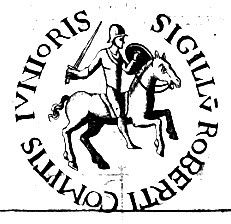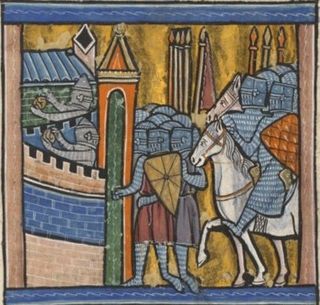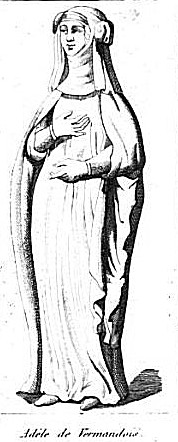
Alexios I Komnenos, Latinized as Alexius I Comnenus, was Byzantine emperor from 1081 to 1118. Inheriting a collapsing empire and faced with constant warfare during his reign, Alexios was able to curb the Byzantine decline and begin the military, financial, and territorial recovery known as the Komnenian restoration. His appeals to Western Europe for help against the Seljuk Turks were the catalyst that sparked the First Crusade. Although he was not the first emperor of the Komnenian dynasty, it was during his reign that the Komnenos family came to full power and initiated a hereditary succession to the throne.

The First Crusade (1096–1099) was the first of a series of religious wars, or Crusades, initiated, supported and at times directed by the Latin Church in the Middle Ages. The objective was the recovery of the Holy Land from Islamic rule. While Jerusalem had been under Muslim rule for hundreds of years, by the 11th century the Seljuk takeover of the region threatened local Christian populations, pilgrimages from the West, and the Byzantine Empire itself. The earliest initiative for the First Crusade began in 1095 when Byzantine emperor Alexios I Komnenos requested military support from the Council of Piacenza in the empire's conflict with the Seljuk-led Turks. This was followed later in the year by the Council of Clermont, during which Pope Urban II supported the Byzantine request for military assistance and also urged faithful Christians to undertake an armed pilgrimage to Jerusalem.

Godfrey of Bouillon was a preeminent leader of the First Crusade, and the first ruler of the Kingdom of Jerusalem from 1099 to 1100. Although initially reluctant to take the title of king, he agreed to rule as prince (princeps) under the title Advocatus Sancti Sepulchri, or Advocate of the Holy Sepulchre.
Bohemond I of Antioch, also known as Bohemond of Taranto or Bohemond of Hauteville, was the prince of Taranto from 1089 to 1111 and the prince of Antioch from 1098 to 1111. He was a leader of the First Crusade, leading a contingent of Normans on the quest eastward. Knowledgeable about the Byzantine Empire through earlier campaigns with his father, he was the most experienced military leader of the crusade.
Nikephoros Bryennios was a Byzantine general, statesman and historian. He was born at Orestias (Adrianople) in the theme of Macedonia.

Robert II, Count of Flanders was Count of Flanders from 1093 to 1111. He became known as Robert of Jerusalem or Robert the Crusader after his exploits in the First Crusade.
The Treaty of Deabolis was an agreement made in 1108 between Bohemond I of Antioch and Byzantine Emperor Alexios I Komnenos, in the wake of the First Crusade. It is named after the Byzantine fortress of Deabolis. Although the treaty was not immediately enforced, it was intended to make the Principality of Antioch a vassal state of the Byzantine Empire.

The Alexiad is a medieval historical and biographical text written around the year 1148, by the Byzantine princess Anna Komnene, daughter of Emperor Alexios I Komnenos. It was written in a form of artificial Attic Greek. Anna described the political and military history of the Byzantine Empire during the reign of her father, thus providing a significant account on the Byzantium of the High Middle Ages. Among other topics, the Alexiad documents the Byzantine Empire's interaction with the Crusades and highlights the conflicting perceptions of the East and West in the early 12th century. It does not mention the schism of 1054 – a topic which is very common in contemporary writing. It documents firsthand the decline of Byzantine cultural influence in eastern and western Europe, particularly in the West's increasing involvement in its geographic sphere. The Alexiad was paraphrased in vernacular medieval Greek in mid-14th century to increase its readability, which testifies to the work's lasting interest.
Tatikios or Taticius was an Eastern Roman general of Turkish origin during the reign of Alexios I Komnenos. His name is also rendered as Tetigus, Tatizius, Tatitius, Tatic, or Tetig.

The siege of Nicaea was the first major battle of the First Crusade, taking place from 14 May to 19 June 1097. The city was under the control of the Seljuk Turks who opted to surrender to the Byzantines in fear of the crusaders breaking into the city. The siege was followed by the Battle of Dorylaeum and the Siege of Antioch, all taking place in modern Turkey.

Isaac Komnenos or Comnenus was a notable Byzantine aristocrat and military commander in the 1070s. Isaac played a major role in the rise to the throne of his younger brother, the Byzantine Emperor Alexios I Komnenos, and remained a leading figure in his brother's administration until his death.
Nikephoros Bryennios the Elder, Latinized as Nicephorus Bryennius, was a Byzantine Greek general who tried to establish himself as Emperor in the late eleventh century. His contemporaries considered him the best tactician in the empire.
William the Carpenter, viscount of Melun, was a French nobleman who participated in the Reconquista in Spain and on the First Crusade. He was notorious for defecting from the army both in Spain and on the crusade, but he was also known for his strength in battle, whence he earned his nickname "the Carpenter." He returned to the Holy Land after the crusade, and nothing further is known of his life or death.

Adelaide of Vermandois was suo jure Countess of Vermandois and Valois from 1080 to 1102. She was the last landed ruler of the Carolingian dynasty.
Manuel Boutoumites or Butumites was a leading Byzantine general and diplomat during the reign of Emperor Alexios I Komnenos, and one of the emperor's most trusted aides. He was instrumental in the Byzantine recovery of Nicaea from the Seljuk Turks, in the reconquest of Cilicia, and acted as the emperor's envoy in several missions to Crusader princes.
Constantine Opos was a notable Byzantine general and aristocrat in the first half of the reign of Emperor Alexios I Komnenos. He participated in the wars against the Normans and the Seljuk Turks, eventually reaching the rank of megas doux.
John Komnenos was a Byzantine aristocrat, the nephew of Emperor Alexios I Komnenos and governor (doux) of the strategically important city and theme of Dyrrhachium from 1091 to c. 1106.

The role of women in the Crusades is frequently viewed as being limited to domestic or illicit activities during the Crusades. While to some extent this is true, some women also took part in other activities, including armed combat in the battles of the Holy Land. This article focuses on the first Crusades and identifies known participants. It also highlights some of the more famous women of the later crusades. For a discussion of the sociological and religious aspects of the mixing of women with the predominantly male crusaders, the reader is referred to the referenced documents.
The armies of Bohemond of Taranto, formed in 1097, include a major component of the First Crusade. He is regarded as the real leader of the First Crusade. He formed a second army in 1107 to defend Antioch but instead used it to attack the Byzantine emperor Alexios I Komnenos, resulting in the Treaty of Devol, codifying Bohemond’s defeat. Runciman estimates that the first army included 500 cavalry and 3500 infantrymen and other estimates that the second army was at 34,000 personnel strength are likely greatly exaggerated.
Alexios Komnenos was a Byzantine aristocrat and nephew of Emperor Alexios I Komnenos. Promoted to the rank of sebastos, he served as doux of Dyrrhachium from 1106 until after 1108. During this time, he led the successful resistance to a siege of Dyrrhachium by Bohemond I of Antioch, leading to the Treaty of Devol.











